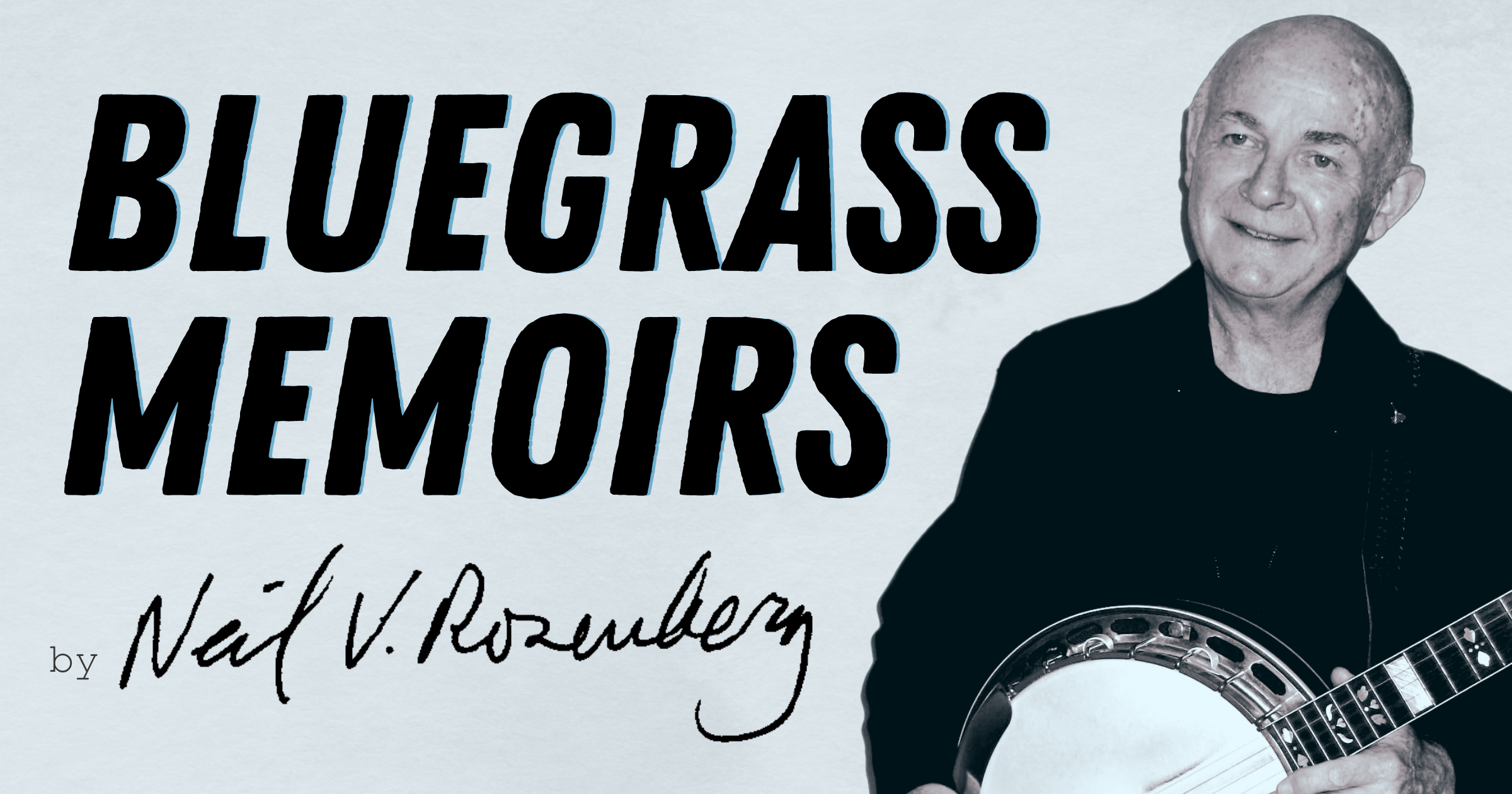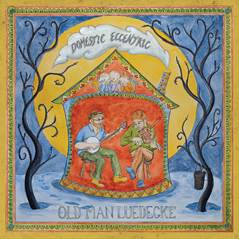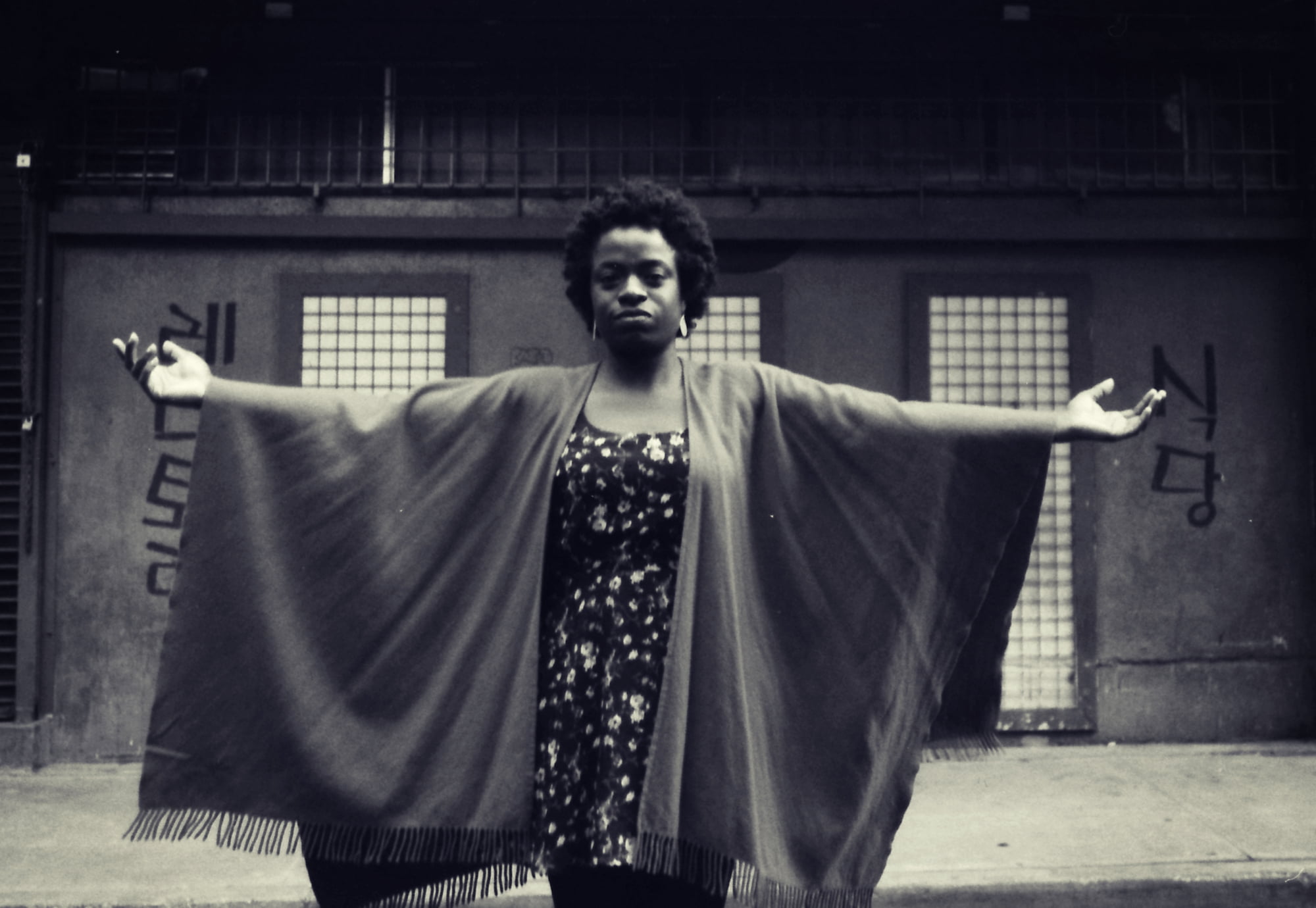(Editor’s note: Read part 1 of Neil V. Rosenberg’s series on the 1987 Earl Scruggs Celebration here.)
My diary for Saturday September 26, 1987 — Earl Scruggs Celebration day at Gardner-Webb College in Boiling Springs, North Carolina — begins with an entry on foodways:
I meet Tom (Hanchett) and Carol (Sawyer) at 7:30 and we walk to the Snack Shop. As Joe had predicted the night before there were lots of pickups outside and quite a few people inside having breakfast. I asked the waitress for livermush and she told me they didn’t have it, that sometimes they did but today they were out of it. It wasn’t on the menu.
After breakfast we walked over to G-W’s Dover Library, Celebration headquarters. Horace Scruggs was there.
Outside Horace took me over to meet his banjo player, and he asked me to play a tune or two. I did “Cumberland Gap” and some other simple tune. The picker then played a lot of fancy stuff and told me about his two banjos.
Inside, people were setting up displays in preparation for the 10:00 opening. It was part museum, part market.
… various people were doing crafts; [an] instrument maker was there with his wife, who played guitar, and his young son (maybe 10) who was a good Scruggs-style banjo picker and played non-stop all afternoon long. They were selling cassettes of him.
Also on sale were books, including my Bluegrass: A History.
Horace had brought in two banjos which Earl had loaned him to be displayed at the Celebration. One was a new Gibson Earl Scruggs model, and the other was the old banjo which had belonged to their father and which Earl had had repaired back in the fifties in Nashville.
Later, Tom would be installing storyboards about the connection between country music and the textiles industry in the Piedmont.
After Horace had set up his display Joe suggested he take us on a tour of the area where the Scruggses grew up. So, Tom, Carol, Joe, and I set out in Horace’s Fury.
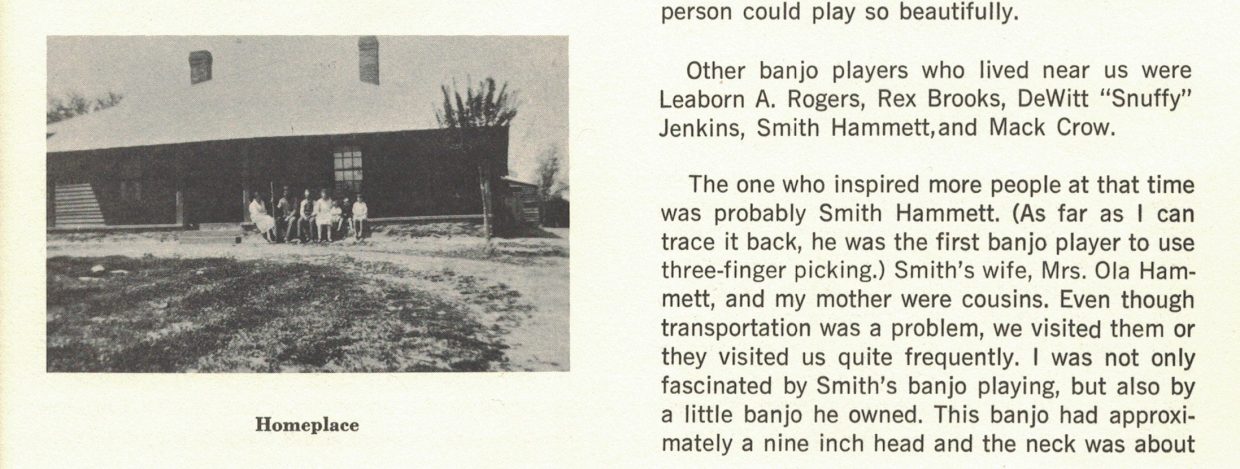
He took us past the Flint Hill Church, their birthplace (depicted in the above photo from p. 147 of Earl Scruggs and the Five-String Banjo), and the house they’d moved to after their father’s death in 1930 (seen below, from p. 150).
The house has the same chimney as in the picture, but the upper part has been rebuilt with brick. A “beware dogs & keep out” sign was posted. Horace said that the family had decided to get rid of the house, but he wished they had kept it. This is the house he and Earl would walk around when practicing time — they would start a tune and each would walk in a different direction playing softly, to see if they could keep their time so they would be together when they met at the back. The right front room, visible from the road, was the one Earl went in when he figured out how to use the third finger in his banjo style.
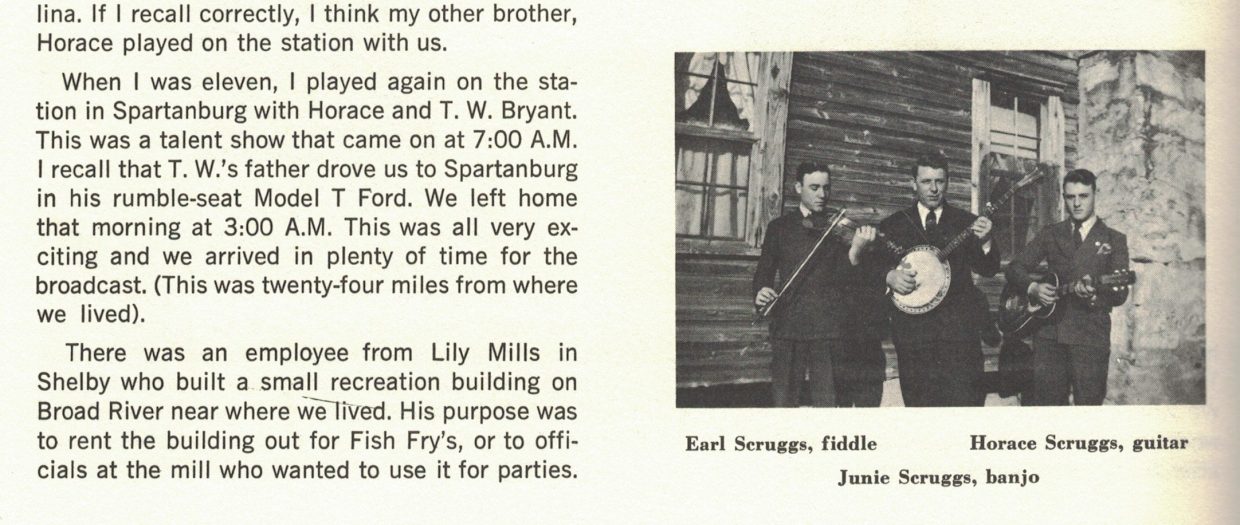
Then Horace took us down to the nearby Broad River to point out the site of Earl’s first professional gig, Ollie Moore’s fish camp.
At 10:00 the Celebration began out in front of the Library. I noted: A beautiful sunny day which was to get up into the low 80s by the feel of it. The president opened the festivities and then Horace and his bandmates in Riverbend performed a few songs.
At last night’s dinner I’d gotten to know a couple from Raleigh, Margaret and Wayne Martin.
Both were old-time musicians. In 1984 they’d joined with two others to found PineCone, the Piedmont Council of Traditional Music, “an organization that would help support traditional roots artists and present their music to the public in a professional and respectful manner.”
An experienced teacher and performer, Margaret was scheduled to workshop with Etta Baker. This was one of the high points of the Celebration.
At 10:30 Margaret Martin set up with Mrs. Etta Baker in the Library lobby and did an hour-long workshop which was very nice. Mrs. B. played banjo some of the time, showing how her daddy picked 2-finger style; then she played the guitar, a D-18 with a built-in pickup, and did her “hits” like “Railroad Bill” and “John Henry” and also some nice Piedmont-style blues like, she said, her sons played. She was low-key but relaxed and effective as a performer, and Martin ran a good workshop, assisting musically but not getting in the way.
In the middle of this Snuffy Jenkins, Pappy Sherrill and the Hired Hands arrived and were standing at the back of the crowd in the lobby. I had a good talk with both of them, trying to give some idea of what I wanted on the workshop.
Banjoist Jenkins and fiddler Sherrill began their careers in the ’30s playing a blend of old-time and country. Snuffy played 3-finger style even before Earl, who acknowledged his influence. Still active after nearly fifty years, they were living history. They’d watched bluegrass develop. What could they say about that? Also, I was particularly interested in having them demonstrate the kind of shows they’d done in their early years — the radio pitches and Snuffy’s baggy-pants comedy.
Unfortunately, Snuffy hadn’t brought along his rig for the full comedy routine but they said they would do some comedy.
I pursued a bit of tune research, wondering about a tune Earl Scruggs had played in his 1945 audition for Monroe. I’d heard that Earl learned it from Snuffy.
I asked Snuffy about “Dear Old Dixie,” which he did play. He told me he learned from a Rutherford County fiddle band, the Barrett Brothers — a group they always beat in contests, he said.
It was noon; Carol and Tom and I took a lunch break. As the afternoon began:
We sat out on the campus green, a broad sloping lawn with a stage at the lower end, and listened to Snuffy Jenkins and Pappy Sherrill along with their band.
The Hired Hands, all younger South Carolinians, included guitarist Harold Lucas; his son Randy, who played banjo and guitar; and Frank Hartley on bass. After a 10-song set, a young guest, Philip Jenkins, was introduced. Philip’s father Hoke was Snuffy’s nephew, a good banjoist who’d recorded with Jim & Jesse in the early ’50s. Philip, playing his dad’s fancy old Gibson, did “Train 45” and “Sally Goodin.”
Snuffy closed out the show by bringing out his “confounded contraption,” a washboard fitted with cowbell, frying pan, wooden block, and an old bicycle horn, on which he played rhythm with eight sewing thimbles as Pappy fiddled “Chicken Reel” and “Alabama Jubilee.”
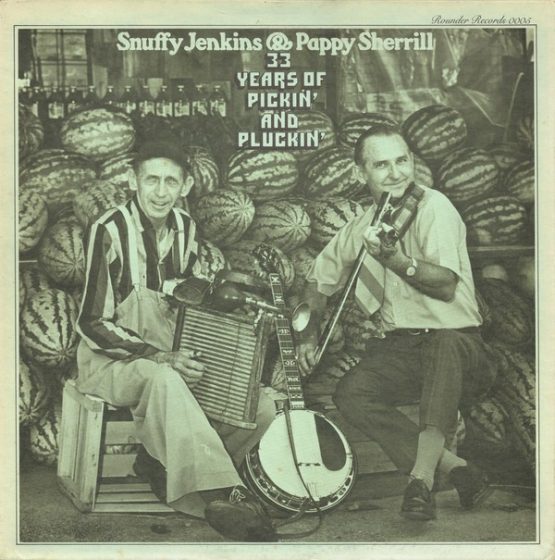
Other bands followed. I wandered around at the back of the crowd, taking in the music from different perspectives and meeting fans. Around two I went back to my room, picked up the tape recorder and headed for the seminar room in the library where the workshop was to be held.
I used the recorder, a Sony Walkman Pro cassette machine with an external mike and a C90 cassette, to record the workshop. What follows is based on a table of contents drafted soon after the event. The tape itself, like most of my research materials, is now in Memorial’s archives, out of reach at the moment.
We began at 3:00 with an introduction by Dr. Brown and a speech of welcome from G-W’s Vice President for Academic Affairs. The band opened up with their theme tune, the old fiddle tune “Twinkle Little Star.” Dr. Brown introduced me and I began in emcee style to introduce the band, a leisurely process involving a bit of humor and local place names. Although this was a workshop, Pappy and Snuffy treated it as a show, offering comic relief and virtuoso instrumentals at regular intervals.
I spoke briefly about the band as living history, mentioning that Pat Ahrens, a writer from Columbia, South Carolina, their base of operations, had written a nice little book about them, with photos, and a discography.
I told how the word “bluegrass” had taken on a musical meaning following Earl Scruggs’ years with Bill Monroe and his Blue Grass Boys, and then asked Snuffy to talk about his early history. It was a question he’d been asked before. He and Homer were prepared. Their response was pretty much like the one on this YouTube clip, recorded in 1988 at the Tennessee Banjo Institute:
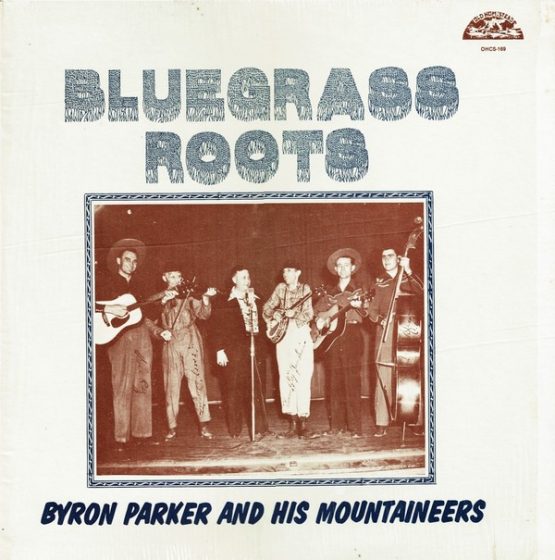
Their regular radio shows enabled them to make the bookings that sustained their early career at the small rural schools dotting the countryside around Columbia. Sponsored on the radio by Crazy Water Crystals, a laxative, they recorded 16 tunes and songs — eight 78s — for RCA Victor in 1940 as Byron Parker and His Mountaineers, with fiddle, guitars, mandolin, banjo and Parker’s bass vocal on the hymns. Their broad repertoire included “Up Jumped The Devil” on which Snuffy took banjo breaks which today sound very bluegrassy:
Pappy Sherrill was the band’s emcee. He told the history of the band, calling their records “old timey stuff, no extra notes.” Many of their songs and tunes would find their way into bluegrass repertoires. I asked Homer for an example; he played “Carroll County Blues,” the fiddle classic from Mississippians Narmour and Smith that they’d recorded in 1940:
Lead singer Harold Lucas began with a joke: “there’s a fine line between old-time and not being able to play at all.” Then, referring to his son Randy, a master of new styles, he described the interplay between old and new generations.
Pappy spoke about growing up listening to the radio. To him, old-time is easier. Bluegrass is fast, with high-pitched singing — not the same. He stressed the importance of duets in old-time.
Randy said “it takes old fellows to play old-time music” and that he got his inspiration from Pappy & Snuffy — “they make music fun.”
As far as he was concerned, said Snuffy, “Ain’t no difference — slow and fast.” He joked about his own “mellow voice — over ripe, almost rotten.”
Returning to the question I’d posed, Pappy and Randy Lucas, now playing banjo, demonstrated the differences between old-time and bluegrass. Pappy fiddled the venerable “Leather Britches” as an example of old-time. Then Randy demonstrated bluegrass with a recent, fancy banjo piece, Don Reno’s “Dixie Breakdown.” Fluent in both styles, each took breaks on both tunes.
I asked about comedy. Pappy described the skits that were an integral part of the Hired Hands show. He said they had a writer, Billy F. Jones, who scripted their comedy pieces, making parts for each member of the band. They weren’t set up to do a skit today, but they did an old traditional musical comic dialogue that originated in 19th century theater, “Arkansas Traveler.” In 1960 the Stanley Brothers had a big record hit with a version that combined the traditional dialogue with new music, titled “How Far to Little Rock”:
Then, after Randy had played “There’s An Old Spinning Wheel in the Parlor” demonstrating his mastery of contemporary banjo styles, Snuffy responded to a request and brought out his “confounded contraption,” the washboard, to play along with Pappy on the popular fiddle favorite, “Down Yonder.” Here’s how Snuffy looked playing washboard on another fiddle favorite, “Alabama Jubilee,” at a festival in 1989:
Nearing the end of the workshop, I called for questions. A number came in from the audience — asking about their sponsor, the history of Snuffy’s washboard, other touring bands, and their Columbia, South Carolina, base.
Finally, Pappy explained that their shows always included hymns; he had a box full of Stamps-Baxter and Vaughn gospel quartet songbooks, and taught the parts to the group from them. They were complex, responsorial. Here’s an example from their 1940 RCA sessions, “We Shall Rise,” with Byron Parker singing bass.
Afterwards he thanked the audience. I concluded with remarks about the band’s role in the change from old to new in folk traditions, and the transition from home and neighborhood to stage and radio.
Just before Dr. Brown formally ended the workshop, well-known local banjoist Dan X Padgett presented a gift — a hat — to Snuffy. I did not note what the hat looked like, and that detail has escaped my memory. But there’s more coming about Dan X Padgett and the rest of the Celebration in Part 3 of this memoir.
(Editor’s note: Read part 1 of Neil V. Rosenberg’s series on the 1987 Earl Scruggs Celebration here.)
Neil V. Rosenberg is an author, scholar, historian, banjo player, Bluegrass Music Hall of Fame inductee, and co-chair of the IBMA Foundation’s Arnold Shultz Fund.
Photo of Neil V. Rosenberg: Terri Thomson Rosenberg
